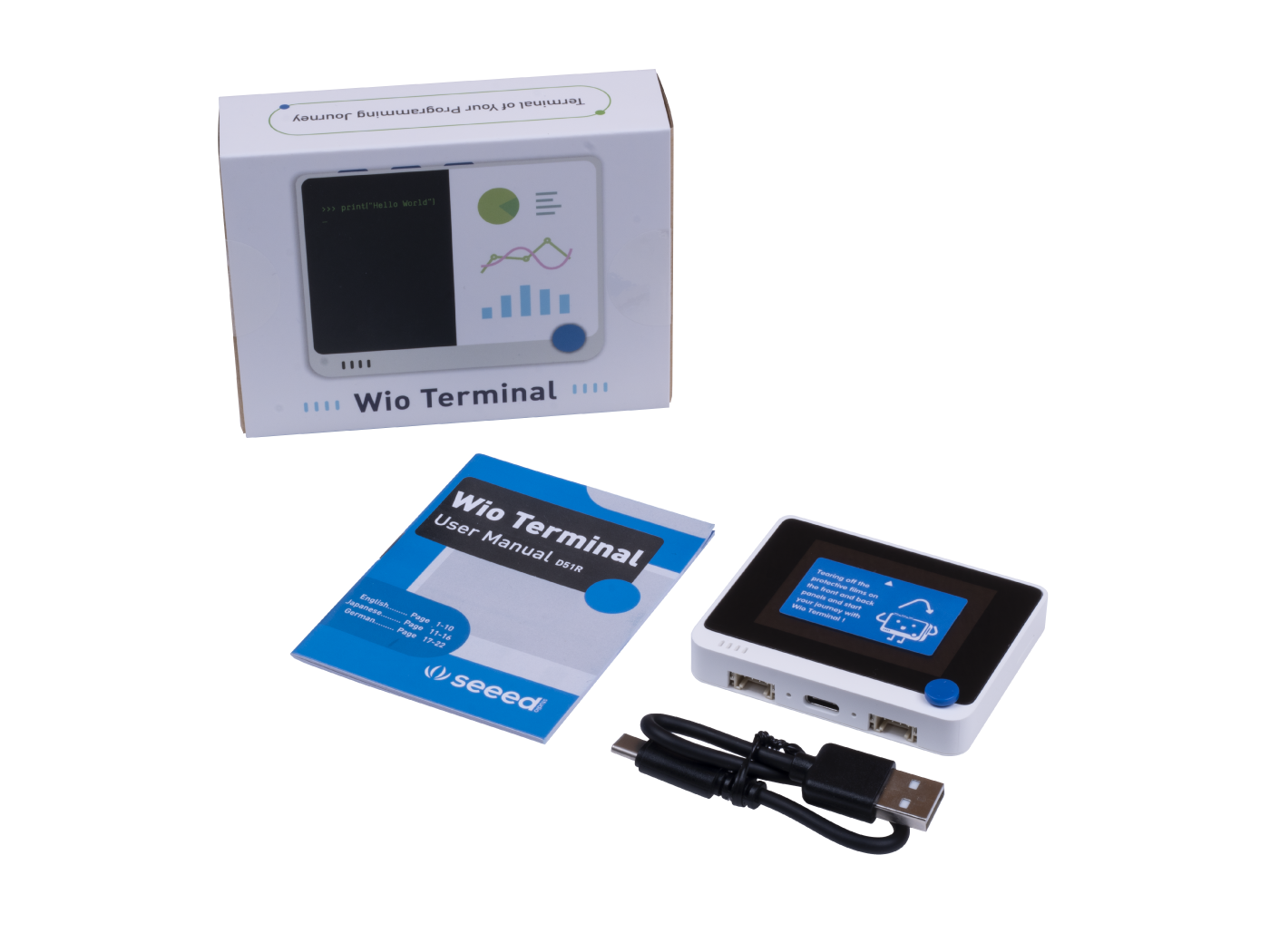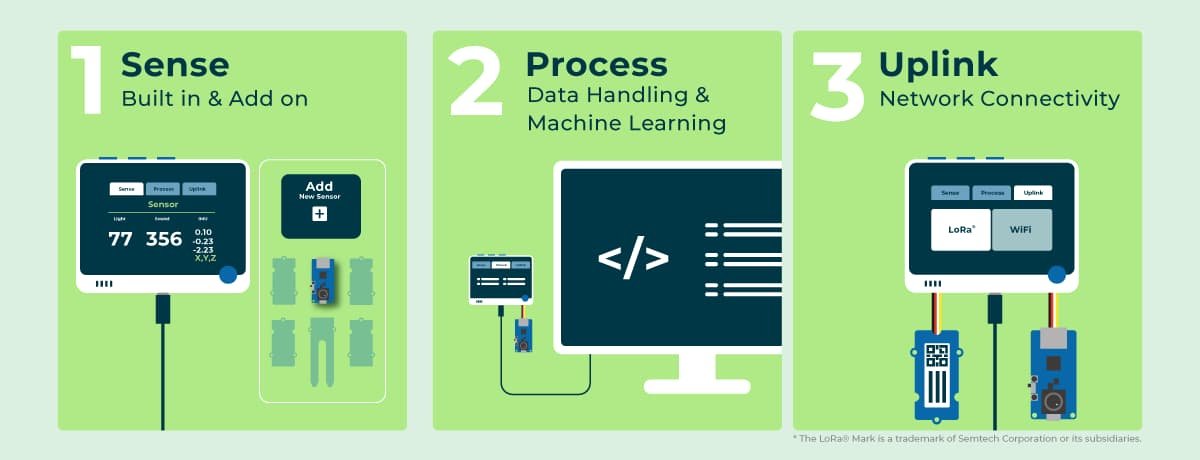Stage 3 Biomaker Kit
The Biomaker IoT wireless kit is perfect for fieldwork, and other applications where remote sensing and transfer of data is useful. It makes use of the Wio Terminal, an Arduino-compatible microcontroller with both Bluetooth and Wi-Fi connectivity. It can be used in conjunction with the Wio battery pack and LoRa module to create wireless communication systems perfect for field and agriculture applications.
The IoT wireless kit includes three integrated components:
the Wio Terminal with built-in screen, sensors, communications and support for hardware expansion
a Remote Battery Pack for portable use or solar power
a LoRa Wireless Module for long range (up to 10 km) communications and connection to open networks for data logging and access.
The Wio Terminal contains a more powerful microcontroller than the Biomaker Stage 1 and 2 Kits, but is Arduino-compatible, and can still be programmed using XOD. In addition, it is compatible with the same hardware sensors and output devices.
To apply for an IoT wireless kit and for direct project applications:
You should have an application or project idea in mind. To apply, please document your idea (name, elevator pitch, 200-word summary and team members) on the Hackster website, and submit your project to the Biomaker Hackster Hub. You can find instructions on how to do this here. Please read the eligibility criteria, judging criteria, call details and code of conduct before applying. For more information please contact the SynBio IRC coordinator at coordinator@engbio.cam.ac.uk.
Wio Terminal
The Seeed Studio Wio Terminal is a SAMD51-based microcontroller with wireless connectivity powered by Realtek RTL8720DN. It runs at 120MHz (Boost up to 200MHz), 4MB External Flash and 192KB RAM. It supports both Bluetooth and Wi-Fi providing backbone for IoT projects. The Wio Terminal itself is equipped with a 2.4” LCD Screen, onboard IMU (LIS3DHTR 3-Axis digital accelerometer), microphone, buzzer, microSD card slot, light sensor, and infrared emitter (IR 940nm). On top of that, it also has two multifunctional ports for Grove devices and 40 Raspberry Pi compatible pin GPIO for more add-ons. It has both Wi-Fi and Bluetooth connectivity making it perfect for a range of applications including IoT.
There are extensie resources available at: https://wiki.seeedstudio.com/Wio-Terminal-Getting-Started/
SenseCAP K1100 Kit
This kit from Seeedstudio contains a Wio Terminal along with a set of sensors including an AI vision sensor and LoRa communication module, all Grove-compatible. More information about the K1100 kit can be found at:
https://www.seeedstudio.com/Seeed-Studio-LoRaWAN-Dev-Kit-p-5370.html
https://wiki.seeedstudio.com/K1100-Getting-Started/#quick-start-with-sensecap-k1100
SenseCAP K1100 Kit hardware components
Grove - Temperature&Humidity Sensor
Grove - Soil Moisture Sensor
Grove - VOC and eCO2 Gas Sensor
Grove - Wio-E5
Grove - Vision AI Module
Wio Terminal Battery
The Wio Terminal Battery Chassis is an extension board for Wio-Terminal Dev Board and it provides an external power source for Wio Terminal to enhance its portability and compactness. It has a 650mAH rechargeable lithium polymer battery, battery charging/discharging status LED, 4 Grove Analog/Digital Ports, 1 Grove I2C Port, and 1 Grove UART Port, as well as an ABS plastic enclosure.
More technical details can be found at: https://wiki.seeedstudio.com/Wio-Terminal-Chassis-Battery(650mAh)/
Wio Terminal LoRaWan Chassis with Antenna
LoRa-E5 is a low-cost, ultra-low power, extremely compact, and high-performance LoRaWAN Module designed by Seeed Technology Co., Ltd. The LoRa-E5 hardware allows long-distance low-bandwidth radio transmission with a range of up to 10km in an open area and around 3km in a built-up urban area. The sleep current of LoRa-E5 modules on board is as low as 2.1 uA (WOR mode).
The module contains an ST system-level package chip STM32WLE5JC, which is a SoC integrated with the combo of LoRa RF and MCU chip (https://wiki.seeedstudio.com/LoRa-E5_STM32WLE5JC_Module/). This module is also embedded with ARM Cortex M4 ultra-low-power MCU and LoRa SX126X, and therefore supports (G)FSK mode and LoRa. 62.5kHz, 125kHz, 250kHz, and 500kHz bandwidth can be used in LoRa® mode, making it suitable for the design of various IoT nodes, supporting EU868 and US915. If you are not quite familiar with LoRa and LoRaWAN, check out this article LoRapedia for detail.
By connecting Wio Terminal LoRaWan Chassis with Antenna-built-in LoRa-E5 and GNSS, EU868/US915 to your development boards, your devices are able to communicate with and control LoRa-E5 conveniently by AT command through UART connection. Grove LoRa-E5 will be a superior choice for IoT device development, testing, and long-distance, ultra-low power consumption IoT scenarios like smart agriculture, smart office, and smart industry.
More details,at: https://wiki.seeedstudio.com/Wio_Terminal_LoRaWan_Chassis_with_Antenna-built-in_LoRa-E5_and_GNSS_EU868_US915/
XOD Software support
The Wio Terminal provides a package and platform for more advanced projects than the Seeed Grove Beginner Kit that is used for Biomaker training. The Wio Terminal is Arduino-compatible and a wide range of Arduino IDE libraries are available, but will benefit from availability of XOD library support for its specialised hardware - to allow no-code programming of the device. Matt Wayland (University of Cambridge) has been working hard to generate new libraries for the Wio Terminal, including the following.
Matt is also converting additional libraries to cover LCD functionality such as fonts, loading images, plotting graphs, etc.
To use the Wio Terminal with XOD you will need to edit the file: xod/__packages__/extra.txt and add the following board definition:https://files.seeedstudio.com/arduino/package_seeeduino_boards_index.json
Wio Terminal hardware:
wayland/wio-terminal-buttons@0.0.2
Nodes for the Wio Terminal user configurable buttons and five-way switch. Wio Terminal is an ATSAMD51-based microcontroller with wireless connectivity powered by Realtek RTL8720DN (https://www.seeedstudio.com/Wio-Terminal-p-4509.html).
wayland/wio-terminal-buzzer@0.0.1
Nodes for the Wio Terminal's built-in buzzer. Wio Terminal is an ATSAMD51-based microcontroller with wireless connectivity powered by Realtek RTL8720DN (https://www.seeedstudio.com/Wio-Terminal-p-4509.html).
wayland/wio-terminal-sensors@0.0.2
Nodes for the Wio Terminal's built-in sensors (accelerometer, light meter and microphone). Wio Terminal is an ATSAMD51-based microcontroller with wireless connectivity powered by Realtek RTL8720DN (https://www.seeedstudio.com/Wio-Terminal-p-4509.html).
Wio Terminal screen control:
wayland/wio-terminal-lcd@0.0.5
Library to drive the LCD of the Wio Terminal. Partially wraps https://github.com/Seeed-Studio/Seeed_Arduino_LCD
wayland/wio-terminal-fonts@0.0.2
Free fonts for the Wio Terminal display. To be used with the draw-string(wt-lcd-device) and draw-string(wt-sprite) nodes in the wio-terminal-lcd library (https://xod.io/libs/wayland/wio-terminal-lcd/).
wayland/wio-terminal-bar-chart@0.0.2
Nodes for drawing bar charts on the LCD screen of the Wio Terminal. Wraps https://github.com/Seeed-Studio/Seeed_Arduino_Histogram
Utilities:
Calculate the coordinates of all rectangles in a user specified grid. Facilitates drawing repeated patterns on a display.
wayland/generate-sequence@0.0.2
Generates a linear sequence of numbers. This patch was created to facilitate the drawing of repeated elements (e.g. gridlines) on displays.
Library provides a single node for calculating the simple moving average (https://en.wikipedia.org/wiki/Moving_average#Simple_moving_average). Based on https://github.com/ThingEngineer/movingAvgFloat which in turn is derived from https://github.com/JChristensen/movingAvg
Communication:
Cayenne Low Power Payload with Extended Data Types. CayenneLPP format is an efficient way to send sensor data over low bit rate connection, like LoRa. Wraps https://github.com/ElectronicCats/CayenneLPP.
Arduino NMEA (National Marine Electronics Association) parsing library (wraps https://github.com/mikalhart/TinyGPSPlus). Provides nodes for extracting position, date, time, altitude, speed, and course from consumer GPS devices. Tested using a NEO-6M.
Advanced projects
SeeedStudio have collected a series of project descriptions for the Wio Terminal - with plenty of inspiration and links to practical assembly details.














